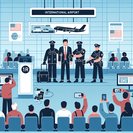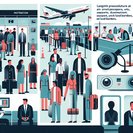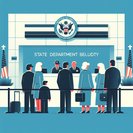
The Department of Homeland Security (DHS) on October 27 published a long-anticipated rule in the Federal Register that will require every non-U.S. citizen— including Canadians who previously enjoyed a carve-out— to be photographed whenever they enter or leave the United States. The regulation, which formally takes effect on December 26, authorizes U.S. Customs and Border Protection (CBP) officers to collect facial images at all airports, seaports and land crossings and to store the data for up to 75 years.
CBP has used facial recognition for arriving international passengers since 2018, but exit records have remained patchy. Officials say the comprehensive program will close long-standing gaps in the congressionally-mandated biometric exit-entry system, help detect passport fraud and curb visa overstays— a group DHS estimates now accounts for roughly 42 percent of undocumented immigrants. The new rule also removes age exemptions that previously spared children under 14 and adults over 79 from biometric capture.
From a business-mobility standpoint, companies should anticipate longer lines at land borders and mixed experiences at airports as technology scales nationwide. Many U.S. hubs already use “Simplified Arrival” e-gates that match live images to passport photos in seconds, but smaller airports and land crossings still rely on manual checks. Employers with frequent cross-border commuters— particularly along the U.S.–Canada corridor— should brief travelers on the added step and build extra time into itineraries through early 2026.
Privacy groups immediately criticized the breadth and retention period of the data, warning of heightened risks of misidentification and mission creep. DHS counters that photographs will be encrypted, stored separately from travel histories and accessible only to vetted personnel. Nevertheless, companies operating employee-travel programs should review internal data-protection policies, update traveler FAQs and watch for possible litigation that could delay implementation.
For multinational firms, the takeaway is clear: comprehensive facial biometrics are becoming the default when crossing U.S. borders. Travel managers should monitor CBP rollout schedules, communicate procedural changes to global assignees and ensure mobility policies account for the new compliance environment.
CBP has used facial recognition for arriving international passengers since 2018, but exit records have remained patchy. Officials say the comprehensive program will close long-standing gaps in the congressionally-mandated biometric exit-entry system, help detect passport fraud and curb visa overstays— a group DHS estimates now accounts for roughly 42 percent of undocumented immigrants. The new rule also removes age exemptions that previously spared children under 14 and adults over 79 from biometric capture.
From a business-mobility standpoint, companies should anticipate longer lines at land borders and mixed experiences at airports as technology scales nationwide. Many U.S. hubs already use “Simplified Arrival” e-gates that match live images to passport photos in seconds, but smaller airports and land crossings still rely on manual checks. Employers with frequent cross-border commuters— particularly along the U.S.–Canada corridor— should brief travelers on the added step and build extra time into itineraries through early 2026.
Privacy groups immediately criticized the breadth and retention period of the data, warning of heightened risks of misidentification and mission creep. DHS counters that photographs will be encrypted, stored separately from travel histories and accessible only to vetted personnel. Nevertheless, companies operating employee-travel programs should review internal data-protection policies, update traveler FAQs and watch for possible litigation that could delay implementation.
For multinational firms, the takeaway is clear: comprehensive facial biometrics are becoming the default when crossing U.S. borders. Travel managers should monitor CBP rollout schedules, communicate procedural changes to global assignees and ensure mobility policies account for the new compliance environment.








